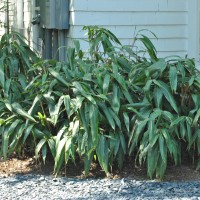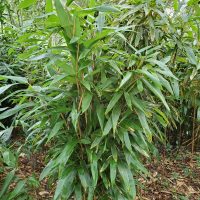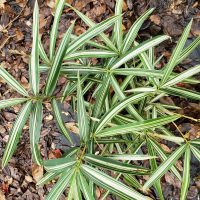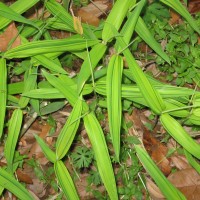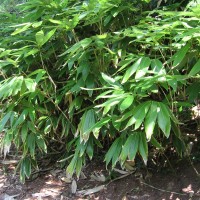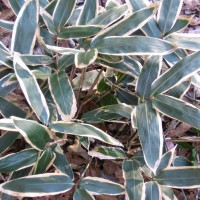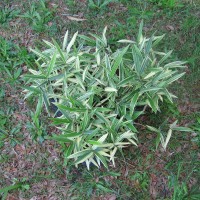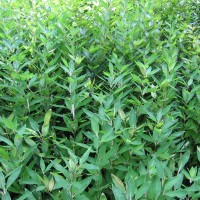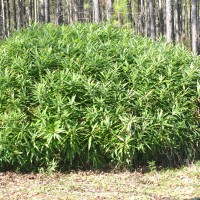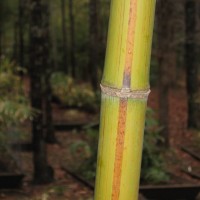| Taller Running Bamboos In Production |
| Photo |
Common Name |
Genus Species |
Max Height (ft.) |
Max Diameter (in.) |
Min Temp (F) |
Shade/Sun
5= Full Sun |
Description |
|
Macon River Cane |
Arundinaria gigantea ‘Macon’ |
20 |
1 |
-22 |
5 |
River cane is the largest of the three North American native bamboos. Native to low woods and riverbanks east of the Appalachians, west to Missouri, up the Mississippi River Valley to southern Illinois and up the Ohio River Valley to southern Ohio. A great choice for native habitat restoration, River Cane once covered large areas in its range, forming extensive “canebreaks”. The ‘Macon’ clone is more upright and hardier than the species. |
|
Switch Cane |
Arundinaria tecta |
8 |
0.5 |
|
5 |
One of three North American native bamboos, Switch Cane is generally shorter in stature and less cold-hardy, but has larger leaves than River Cane. Its native habitat is primarily moist sites of the Coastal Plain of the southeast from southern Maryland to Alabama and Mississippi. A great choice for native habitat restoration, Switch Cane once formed extensive “canebreaks” in its native range. Switch Cane is much more common than River Cane in our area. |
|
Chinese Walking Stick |
Chimonobambusa tumidissinoda |
20 |
1.3 |
10 |
3 |
A beautiful, rare ornamental with prominent nodes and fine foliage. Needs a moist, shady site in the Deep South. |
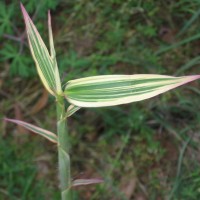 |
Shiroshima |
Hibanobambusa tranquillans ‘Shiroshima’ |
16 |
1.3 |
0 |
4 |
Beautiful, variegated foliage with cream, pink, and green tones. One of our favorites. Does well in sun or shade. |
|
Golden Bamboo |
Phyllostachys aurea |
35 |
2.5 |
0 |
5 |
This is the most commonly cultivated bamboo in the U.S. Makes a very thick, low-branching, evergreen screen. Good-quality wood and ornamental canes with compressed basal nodes. Used for walking sticks, umbrella handles, and fishing rods in China. |
|
Inversa |
Phyllostachys aurea ‘Flavescens Inversa’ |
27 |
1.8 |
0 |
5 |
Same as P. aurea, but with green canes/yellow groove. |
|
Golden Golden |
Phyllostachys aurea ‘Holochrysa’ |
27 |
1.8 |
0 |
5 |
Canes are more golden than the species. |
|
Koi |
Phyllostachys aurea ‘Koi’ |
27 |
1.8 |
0 |
5 |
Same as P. aurea, but with yellow canes/green grooves giving it a unique, ornamental appearance. |
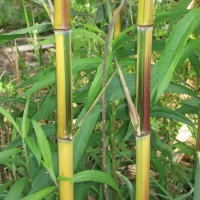 |
Green Groove |
Phyllostachys aureosulcata ‘Spectabilis’ |
26 |
1.5 |
-10 |
5 |
This is the most attractive of the P. aureosulcata varieties. Yellow canes with a green groove. Canes hold their color well and have beautiful foliage. Handles windy sites better than Yellow Groove Bamboo. Highly recommended. |
|
Japanese Timber Bamboo |
Phyllostachys bambusoides |
72 |
6 |
5 |
5 |
One of the largest bamboos that grows in our area. Very hard wood is suitable for many uses. Slow to size up but worth the wait if you’re after quality bamboo poles! This is the most used bamboo in Japan. |
|
Slender Crookstem |
Phyllostachys bambusoides ‘Slender Crookstem’ |
60 |
3 |
0 |
5 |
As its name implies, many canes will exhibit a slight zig-zag in their lower nodes, making Slender Crookstem an excellent choice for a specimen grove. Also seems to be a more vigorous grower than standard P. bambusoides and can attain similar height with the same excellent wood quality. |
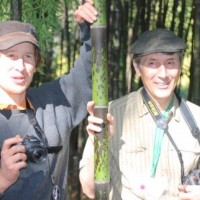 |
Tanakae |
Phyllostachys bambusoides ‘Tanakae’ |
|
|
|
5 |
Another of our favorites, Tanakae has purplish-brown spotting on green canes. The spotting is very ornamental and older canes eventually turn mostly black. Like all of the P. bambusoides varieties, Tanakae has high-quality wood. Tanakae can be used as a substitute for black bamboo on hot, dry sites where black bamboo will not thrive. Tanakae is also more erect-growing and more vigorous than black bamboo, which tends to have a leaning habit. |
|
Bisset’s Bamboo |
Phyllostachys bissetii |
40 |
2 |
-15 |
5 |
One of the most cold-hardy bamboos and one of the most popular for creating green screens in cold climates. Dense, dark green foliage. |
|
Sweetshoot Bamboo |
Phyllostachys dulcis |
40 |
2.8 |
0 |
5 |
Very ornamental, relatively quick to size up, and high-quality edible shoots. Canes achieve larger diameter in relation to height than other Phyllostachys. Highly recommended for edible shoots and ornamental value, but wood quality is inferior. |
|
Anderson Moso |
Phyllostachys edulis ‘Anderson’ |
75 |
7 |
0 |
5 |
Moso is the largest of the hardy bamboos and is the most used bamboo in China. Slow to size up but worth the wait. Very high-quality wood and a very beautiful bamboo. The ‘Anderson’ clone is more cold-hardy than the species. |
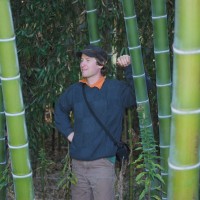 |
Moso |
Phyllostachys edulis |
75 |
7 |
-6 |
5 |
Moso is the largest of the hardy bamboos and is the most used bamboo in China. Slow to size up, but worth the wait. Very high-quality wood and a very beautiful bamboo. |
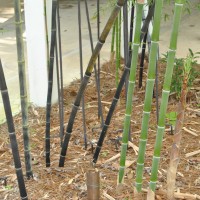 |
Black Bamboo |
Phyllostachys nigra |
30 |
2 |
0 |
5 |
Black bamboo is the most popular of the taller running bamboos. New canes turn black after 6 months to a year. Good quality wood and very ornamental. Excellent choice for a specimen grove but prefers light shade and ample moisture in the Deep South. For hot, dry sites, P. bambusoides ‘Tanakae’ can be a good substitute for black bamboo, as its canes will eventually turn black. |
|
Giant Gray |
Phyllostachys nigra ‘Henon’ |
65 |
4.5 |
0 |
5 |
A very beautiful bamboo, probably the mother form of black bamboo. Canes have a grayish hue. Extremely drought-tolerant. One of the best overall for a specimen grove and good wood quality. |
|
Megurochiku |
Phyllostachys nigra ‘Megurochiku’ |
54 |
3.5 |
0 |
5 |
Similar to Henon, but canes have brown grooves. Megurochiku is a rare and much sought-after bamboo. |
|
Red-Margin Bamboo |
Phyllostachys rubromarginata |
55 |
2.8 |
-5 |
5 |
Rubromarginata is a very vigorous grower, and is tolerant of cold, dry winds. Tests in Alabama have shown it to be superior in cane production. Good quality wood and edible shoots. Excellent screening bamboo. Highly recommended. |
|
Robert Young |
Phyllostachys viridis ‘Robert Young’ |
40 |
3 |
-5 |
5 |
A very popular, cold-hardy ornamental. Beautiful yellow canes and random green striping. Good quality wood and very drought-tolerant. |
|
Vivax |
Phyllostachys vivax |
70 |
5 |
-5 |
5 |
Similar to P. bambusoides, but quicker to size up and more ornamental with nicer foliage. However, canes are thin-walled and wood quality is inferior. |
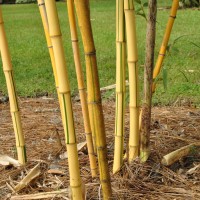 |
Golden Vivax |
Phyllostachys vivax ‘Aureocaulis’ |
70 |
5 |
-5 |
5 |
Another of our favorites. Same as Vivax, but with golden canes and random green striping. One of the best choices for a large specimen grove. |
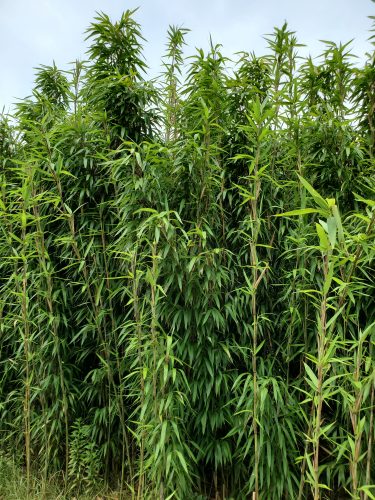 |
Tonkin Cane |
Pseudosasa amabilis |
50 |
2.5 |
15 |
5 |
Very beautiful, tropical look. Great bamboo to plant as a specimen grove. This is the bamboo used to make high end fly-fishing rods. Good-quality wood. |
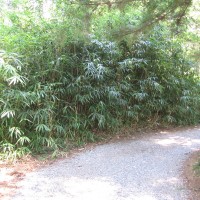 |
Arrow Bamboo |
Pseudosasa japonica |
18 |
0.8 |
0 |
5 |
Arrow bamboo is a great cold-hardy screening bamboo with a tropical look. Less aggressive than other tall runners, can take sun or shade, and makes a great container plant. Also wind and salt-tolerant. |
|
Green Onion Bamboo |
Pseudosasa japonica ‘Tsutsumiana’ |
18 |
0.8 |
0 |
5 |
Similar to Arrow Bamboo, but with swollen internodes shaped somewhat like a green onion. Good container bamboo and also a good screening choice. Less aggressive than other runners. |
|
Temple Bamboo |
Semiarundinaria fastuosa |
30 |
1.5 |
-5 |
5 |
Very erect canes turn purplish or reddish in the sun. Good-quality wood and a very beautiful bamboo. Handles salt spray well. Makes an excellent specimen grove, but is slow to establish. |
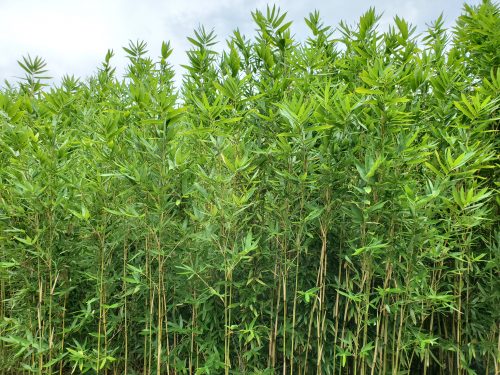 |
|
Semiarundinaria okuboi |
25 |
1.5 |
0 |
5 |
Excellent screening bamboo and a very vigorous grower. |
|
|
Sinobambusa tootsik ‘Albostriata’ |
30 |
1.5 |
10 |
5 |
Erect canes and variegated foliage. Highly recommended for warmer climates. |


